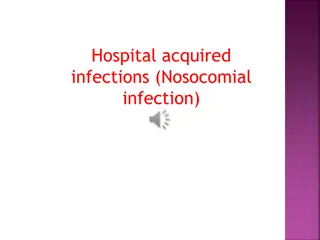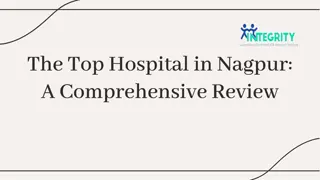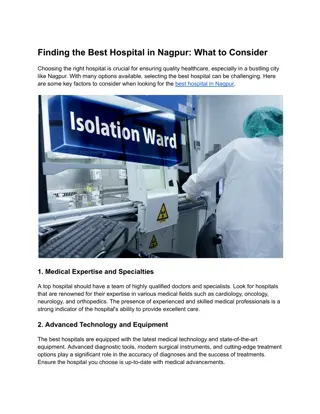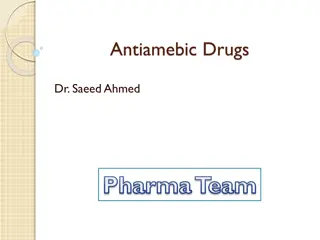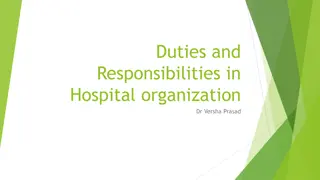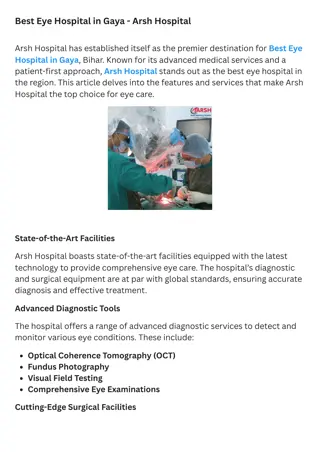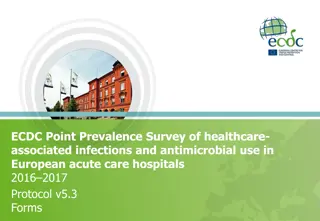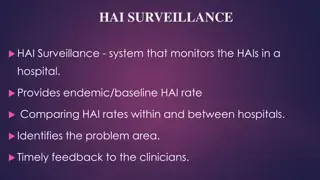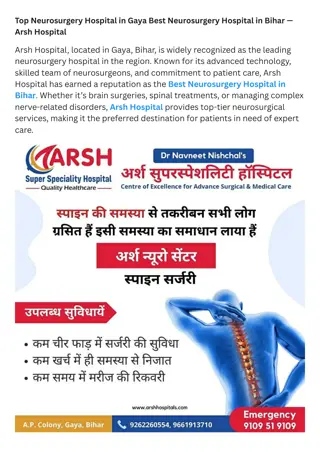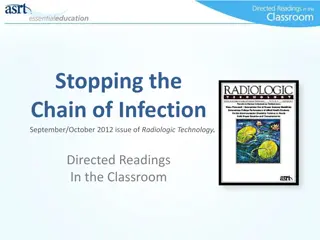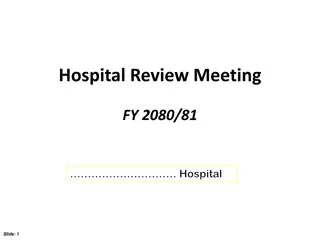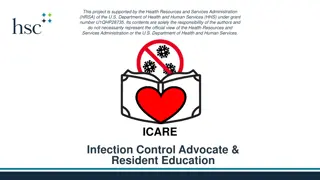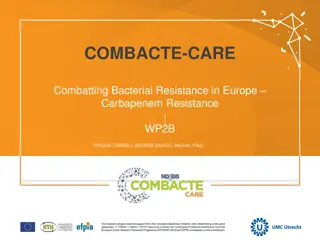Understanding Health Care-associated Infections (HCAI) in Hospital Settings
Health care-associated infections (HCAI), also known as nosocomial or hospital infections, are infections that occur in patients during their hospital stay or after discharge. These infections can result from various sources, including colonization by microorganisms and exposure to contaminated environments or healthcare workers. HCAIs pose a significant risk to patients, with mortality rates ranging up to 45% in some cases. Understanding the sources of infection and risk factors can help in prevention and management strategies.
Download Presentation

Please find below an Image/Link to download the presentation.
The content on the website is provided AS IS for your information and personal use only. It may not be sold, licensed, or shared on other websites without obtaining consent from the author. Download presentation by click this link. If you encounter any issues during the download, it is possible that the publisher has removed the file from their server.
E N D
Presentation Transcript
Health Care-associated Infection (HCAI) (Nosocomial or hospital infection) FAHAD AL MAJID. MD ASSOCIATE PROF OF MEDICINE. 1439
Health Care-associated Infection (HCAI) ( Nosocomial or hospital infection) An infection occurring in a patient during the process of care in a hospital or other health-care facility which was not present or incubating at the time of admission. This includes infections acquired in the health-care facility but appearing after discharge.
Health careassociated infection is a condition in which patients first manifest fever during active medical treatment for some other illness. Surgical procedures Urinary and respiratory tract instrumentation, Intravascular devices .septic thrombophlebitis Drug therapy.. Immobilization , recurrent pulmonary emboli, Clostridium difficile colitis.
Colonization The presence of microorganisms on Skin, on mucous membranes, Open wounds, or Excretions or secretions BUT : are not causing adverse clinical signs or symptoms.
HEALTH CARE WORKERS. Workers in the health care are at risk of occupational exposure to bloodborne: Exposures can occur : 1) Via needle stick injury, exposure to mucous membranes, or non-intact skin: HIV/AIDS , Hepatitis B and Hepatitis C .. 2) Person s respiratory secretions, such as through coughing Tuberculosis , MERS-COV, H1N1..
Estimated rates of HCAI worldwide In modern health-care facilities in the: Developed world: 5 10% of patients acquire one or more infections Developing countries the risk of HCAI might exceed 25%. In intensive care units, HCAI affects about 30% of patients and the attributable mortality may reach 45%
Source of infection 1) Endogenous Body sites, such as the skin, nose, mouth, gastrointestinal (GI) tract, that are normally inhabited by microorganisms. 2) Exogenous : Sources are those external to the patient, such as: A) Patient care personnel, visitors, B) Patient care equipment, medical devices, or C) The health care environment.
Source of infection Four categories of infections account for approximately 75% of HAIs in the acute care Hospital setting: 1. Surgical site infections 2. Central line-associated bloodstream infections 3. Ventilator-associated pneumonia 4. Catheter-associated urinary tract infections
HEALTH CARE ASSOCIATED INFECTION infections associated with Clostridium difficile, Methicillin-resistant Staphylococcus aureus (MRSA) Multi-drug resistant organisms (MDROs) Contribute significantly to the overall problem.
Catheter Catheter- -associated urinary tract infections .. associated urinary tract infections .. 34 34% % UTI that is acquired in a hospital The vast majority of nosocomial UTIs occur in patients whose urinary tracts are currently or recently catheterized.
Catheter Catheter- -associated urinary tract infections.. associated urinary tract infections..35 35- -45 45% % Pathogenesis Pathogenesis Pathogen Spread up the periurethral space from the patient: 1) perineum 2) GI-Tract OR Via intraluminal contamination of the catheter
Catheter Catheter- -associated urinary tract infections associated urinary tract infections Male and female, female predominance Age Urinary catheter Sex Extraluminal: fecal organisms ascend catheter-urethra Main risk factor Intraluminal: fecal or exogenous (cross-infection) organisms enter drainage system Pathogenesis Less virulent than in uncomplicated UTI Single (short-term catheter) Uropathogen multiple (long-term catheter): gram-negatives, gram-positives, Candida sp. virulence CA-bacteriuria in about 5% per day of catheter; >90% is CA-ASB, usually Persistent, most do not progress to CA-UTI. Microbiology CA-UTI: fever, altered mental status, usually no lower tract symptoms Clinical CA-UTI: 103CFU/mL Diagnosis Multidrug resistance common 5-14 day regimen, depending on severity Resistance Reduce urinary catheterization; condom, intermittent or suprapubic catheter vs. indwelling urethral catheter; strict closed system with indwelling urethral catheter Treatment
Catheter Catheter- -associated urinary tract infections..35 associated urinary tract infections..35- -45% 45% Urinary catheter Urinary invasive procedures.. 15-25% of hospitalized patients receive urinary catheters during their hospital stay .. 3% of bacteriuric develop: bacteremia Important source of multi-drug resistant bacteria.
Catheter Catheter- -associated urinary tract infections.. associated urinary tract infections..35 35- -45 45% % The most important risk factor for developing a catheter-associated UTI (CAUTI) is: prolonged use of the urinary catheter
Catheter Catheter- -associated urinary tract infections.. associated urinary tract infections..35 35- -45 45% % Impact of CAUTI: Increased mobidity, mortality Hospital cost, and length of stay. Bacteriuria can lead to : unnecessary antimicrobial use, and urinary drainage systems are often reservoirs for multidrug-resistant bacteria and a source of transmission to other patients.
Catheter Catheter- -associated urinary tract infections.. associated urinary tract infections..35 35- -45 45% % Diagnosis: Symptomatic urinary tract infection: Must meet at least 1 of the following criteria Fever ( 38.8C), urgency, frequency, dysuria, or suprapubic tenderness and A positive urine culture, that is, >105 microorganisms per 1 cc of urine with no more than 2 species of microorganisms.
Catheter Catheter- -associated urinary tract infections..35 associated urinary tract infections..35- -45% 45% Asymptomatic bacteriuria Must meet at least 1 of the following criteria: an indwelling urinary catheter within 7 days and a positive urine culture, with no more than 2 species of microorganisms and NO fever (.388C), urgency, frequency, dysuria, or suprapubic tenderness. A positive culture of a urinary catheter tip is not an acceptable laboratory test to diagnose a urinary tract infection.
Catheter Catheter- -associated urinary tract infections.. associated urinary tract infections..35 35- -45 45% % Prevention: A] Catheters only when necessary and for the shortest time. B] Properly trained individuals are responsible for insertion C] Hand hygiene before and after insertion or manipulation of the catheter. D] Maintain unobstructed urine flow The collection bag below the level of the bladder
Central Line Central Line- -associated Bloodstream Infection (CLABSI) associated Bloodstream Infection (CLABSI) 14 14 % % Aleast one (1) of the following criteria: a. ) acquired during hospitalisation and not present or incubating on admission; b.) is a complication of the presence of an indwelling medical device: (e.g., IV catheter, urinary catheter); Vascular catheter Severe underlying disease Neutropenia Immunodeficiency New invasive technologies Lack of training and supervision
Central Line Central Line- -associated Bloodstream Infection (CLABSI) associated Bloodstream Infection (CLABSI) 14 14 % % An important cause of morbidity and mortality Most are associated with intravascular catheters, and central venous catheters in particular (90%). Criterion 1 (recognized pathogens) : Isolation of one or more recognized bacterial or fungal pathogens from one or more blood cultures Staphylococcus aureus, Gram negative bacilli accounted for 19% and 21% of CLABSIs reported to CDC Candida albicans.
Central Line Central Line- -associated Bloodstream Infection (CLABSI) associated Bloodstream Infection (CLABSI) 14 % 14 % Criterion 2 : The patient has at least one of the following signs and symptoms within 24 hours of a positive blood culture being collected: Fever (>38 C); Chills or rigors; or Hypotension ..AND AT LEAST : isolation of the same potential contaminant from two (2) or more blood cultures drawn on separate occasions within a 48 hour period.
Catheter factors Location of the catheter. Duration of catheterization Type of catheter material Conditions of insertion Catheter-site care Skill of the catheter inserter
Femoral or internal jugular placement compared with subclavian Use for hyperalimentation or hemodialysis compared with other indications Submaximal compared with maximal (mask, cap, sterile gloves, gown) barrier precautions during insertion .
89-90% of these infection is caused by : central vascular catheter . Pathogenesis: Microflora at the insertion site migrate extraluminally to the catheter tip usually during the 1stwk after insertion. Extrenisic contamination cause up to 50% of bacteremia with arterial line insertion for hemodynamic monitoring.
Laboratory-confirmed bloodstream infection must meet at least 1 of the following criteria: 1.Patient has a recognized pathogen cultured from 1 or more blood cultures and organism cultured from blood is not related to an infection at another site. 2.Patient has at least 1 of the following signs or symptoms: fever (.388C), chills, or hypotension
Prevention For clinician: Follow proper insertion practices Perform hand hygiene before insertion Adhere to aseptic technique (Education) Use maximal sterile barrier precautions (i.e., mask, cap, gown, sterile gloves, and sterile fullbody drape) Perform skin antisepsis with >0.5% chlorhexidine with alcohol Choose the best site to minimize infections and mechanical complications o Avoid femoral site in adult patients Cover the site with sterile gauze or sterile, transparent, semipermeable dressings
Remove peripheral venous catheters if the patients develops signs of: phlebitis (warmth, tenderness, erythema or palpable venous cord), infection, or a malfunctioning catheter
SURGICAL SITE INFECTION SURGICAL SITE INFECTION 17 17% % A surgical site infection is an infection that occurs after surgery in the part of the body where the surgery took place. SURGICAL SITE INFECTIONS 17% Inadequate antibiotic prophylaxis Incorrect surgical skin preparation Inappropriate wound care Risk is high: Surgical intervention duration Type of wound Poor surgical asepsis Diabetes Nutritional state Immunodeficiency Lack of training and supervision
SURGICAL SITE INFECTION SURGICAL SITE INFECTION Occur in 2% 5% of patients undergoing inpatient surgery. account for 17-20% of all HAIs in hospitalized patients Each SSI is associated with approximately 7 11 additional postoperative hospital-days Patients have a 2 11-times higher risk of death compared with operative patients without an SSI.
SURGICAL SITE INFECTION SURGICAL SITE INFECTION Patient has at least 1 of the following: A) Purulent drainage from the superficial incision b) Organisms isolated from an aseptically obtained culture of fluid or tissue from the superficial incision C) at least 1 symptom or sign of infection: 1) Pain or tenderness, 2) Localized swelling, redness, or heat.
Diagnosis Diagnosis Patient has at least 1 of the following: a) Purulent drainage from the deep incision b) a Deep incision spontaneously dehisces or is deliberately opened by a surgeon and is culture-positive or not cultured . when the patient has at least 1 : 1) fever (.388C), or 2) localized pain or tenderness. Aculture-negative finding does not meet this criterion.
SURGICAL SITE INFECTION SURGICAL SITE INFECTION The mmost common organisms: Coagulase-negative staphylococci 31 percent Staphylococcus aureus 20 percent Enterococci 9 percent Candida species 9 percent Escherichia coli 6 percent Klebsiella species 5 percent Pseudomonas species 4 percent Enterobacter species 4 percent Serratia species 2 percent Acinetobacter baumannii 1 percent
Prevention of SSIs Prevention of SSIs CDC infection prevention guidelines : Clean hands and arms up to the elbows with an antiseptic agent just before the surgery. Clean hands with soap and water or an alcohol-based hand rub before and after caring for each patient. Wear special hair covers, masks, gowns, and gloves during surgery to keep the surgery area clean. Use prophylactic antibiotics if indicated.. Clean the skin at the site of your surgery .
SURGICAL SITE INFECTION SURGICAL SITE INFECTION Administer prophylactic antibiotics within 1 hour of before surgery and Discontinue within 24 hours Select appropriate agents on the basis of the surgical procedure, the most common pathogens causing SSIs for a specific procedure. Redose prophylactic antimicrobial agents for long procedures
Pathogenesis 1) migration of skin organisms at the insertion site into the cutaneous catheter tract and along the surface of the catheter with colonization of the catheter tip. this is the most common route of infection for short-term catheters 2) direct contamination of the catheter or catheter hub by contact with hands or contaminated fluids or devices 3) less commonly, catheters might become hematogenously seeded from another focus of infection [ 4) rarely, infusate contamination might lead to CRBSI
LOWER RESPIRATORY TRACT INFECTIONS LOWER RESPIRATORY TRACT INFECTIONS Mechanical ventilation Aspiration Nasogastric tube Central nervous system depressants Antibiotics and anti-acids Prolonged health-care facilities stay Malnutrition Advanced age Surgery Immunodeficiency
Health care associated Health care associated pneumonia pneumonia Pneumonia that occurs 48 hours or more after admission and did not appear to be incubating at the time of admission. Ventilator-associated pneumonia (VAP) is a type of HAP that develops more than 48 to 72 hours after endotracheal intubation
Health care associated Health care associated pneumonia pneumonia Pneumonia has accounted for approximately 15% of all hospital- associated infections. and 27% of all infections acquired in the medical intensive-care unit (ICU) and and 24% coronary care unit. the second most common hospital-associated infection after that of the urinary tract
Health care associated Health care associated pneumonia pneumonia. Pneumonia: 15-20% but IT cause 40% extra cost in hospital. Atiology : Aspiration of endogenous or hospital acquired oropharyngeal flora. A leader cause of mortality among HCAI. The most common and lethal is: Ventilator-associated pneumonia: 5-15% death.
Health care associated Health care associated pneumonia pneumonia Risk factors: (Events) A} Factors that increase colonization by potential pathogens: 1) prior antimicrobial therapy. 2) contamination of ventilator circuits. 3) Decreased gastric acidity.
Health care associated Health care associated pneumonia pneumonia B} factors facilitate aspiration of oropharyngeal contents: 1) Intibuation 2) Decreased level of consciousness. 3) Presence of nasogastric tube. C} factors that reduce the host defense: 1) Chronic lung disease 2) Old age 3) Upper abdominal surgery.
DIAGNOSIS DIAGNOSIS Fever, cough, and development of purulent sputum. Rdiologic evidence of a new or progressive pulmonary infiltrate, leukocytosis,
Prevention of health care-associated infection Validated and standardized prevention strategies have been shown to reduce HCAI At least 50% of HCAI could be prevented Most solutions are simple and not resource-demanding and can be implemented in developed, as well as in transitional and developing countries Hands are the most common vehicle to transmit health care- associated pathogens . Transmission of health care-associated pathogens from one patient to another via health-care workers hands .
Isolation Standard precautions: Gloving and hand cleansing for potential contact with : 1) blood 2) all other body fluid ,secretion or excretion 3)non-intact skin 4) mucus membrane
Patient with potentially contagious clinical syndrom: Diagnosed to be colonized or infected with transmissible organism through: airborne, droplet, and contact: pulmonary tuberculosis meningitis etc
Tuberculosis Tuberculosis (TB) is an airborne disease Prompt recognition..Atypical presentation. Isolation Treatment The room : Negative pressure 100% exhaust Private isolation with closed door. Use of N95 respirators. Follow the contact and test for infection.
SPECIAL INFECTION SPECIAL INFECTION Transmission of multidrug-resistant/marker organisms MRSA VRE Carbapenem-resistant Acinetobacter ESBL-producing organisms MDR Enterobacteriaceae C. difficile Aspergillus in burn and immunocompromised populations Tuberculosis Human Immunodeficiency Virus (HIV Influenza meningitis
SPECIAL INFECTION SPECIAL INFECTION Clostridium difficile Clostridium difficile is a bacterium that causes colitis. Diarrhea and fever are the most common symptoms of Clostridium difficile infection. Overuse of antibiotics is the most important risk for getting Clostridium difficile infection.





